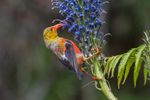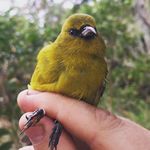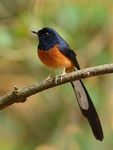Kiwikiu news - Maui Forest Bird Recovery Project
←
→
Page content transcription
If your browser does not render page correctly, please read the page content below
S emi Ann ual R epo rt S umm er 201 8
Kiwikiu
news
‘I’iwi listing on ESA: What does it really mean?
On October 20, 2017, the ‘I’iwi was listed as “threatened” under the Endangered Species Act
(ESA). ‘I’iwi are now federally “protected” but what does that truly mean?
‘I’iwi were petitioned for listing in 2010 by the Center for Biological Diversity and Dr. Tony
Povilitis (Life Net) (husband of former MFBRP project coordinator, Dusti Becker). It was not
until January 24, 2012 that a 90-day finding for ‘I’iwi was published and warranted for the
Federal Register. USFWS determined that ‘I’iwi met two of the criteria for a threatened or
endangered species: its susceptibility to avian malaria and the expected reduction in
disease-free habitat because of increased temperatures caused by climate change. USFWS
published a final listing rule in October 2017 that ‘I’iwi are a “Threatened” species, and the
rule became effective 30 days after publication in the Federal Register.
Now that ‘I’iwi has FEDERAL protection, what’s next? USFWS and other government
agencies are now required by law to determine and designate critical ‘I’iwi habitat and how
to best protect it while also addressing threats to ‘I’iwi (avian malaria and climate change). In
order to achieve these goals, the agency will have to collaborate with scientists and stakeholders to create a recovery plan
for ‘I’iwi and determine exactly what ‘I’iwi critical habitat is. However, a listing does not necessarily mean that anyone will
receive more funding to achieve this. This may mean reallocating current resources away from other threatened or
endangered species to focus efforts on ‘I’iwi research and recovery. Fortunately, focusing efforts on preserving ‘I’iwi critical
habitat will in-turn preserve habitat for other threatened and endangered native forest birds of Hawai’i.
With a population of ~600,000, ‘I’iwi have been listed at a time where the species has not
yet reached endangered status. Oftentimes, species protection is categorized as a sort of
triage method, focusing all funding and resources towards species most critically
endangered in an effort to race against time to save them from extinction. This type of
system currently restricts conservation efforts from concentrating on species before they
reach the endangered species list. In the case of ‘I’iwi, a “threatened” listing is more of a
call to action BEFORE the population is in such decline that it, too, falls into the
endangered species category. Saving a species becomes much more difficult the closer it
gets to extinction and to date, no endangered Hawaiian forest bird has recovered enough to
be delisted, placing extra pressure and hope that ‘I’iwi will be able to bounce back.
Currently, experts have stated that the most urgent need to protect ‘I’iwi and other
endangered Hawaiian forest birds lies in the removal or management of mosquitoes. While
most of the populations of ‘I’iwi are currently found on three islands (Hawai’i, Maui and
Kaua’i), models project that ‘I’iwi will lose 60-90% of their disease-free range by the end of
the century. New forms of vector control are on the horizon but have to be implemented. In
addition to mosquitoes and climate change, the threat of rapid ʻōhiʻa death (fungal disease
killing ʻōhiʻa, an important ‘I’iwi foraging and nesting tree) is limiting disease-free forest
habitat. Addressing and alleviating these threats within the near future may determine the
fate of this species.
Photos: Top: ‘I’iwi by Randy Bartlett. Right: Juvenile ‘I’iwi by Mike Neal. Left: USFWS.
MAUI FOREST BIRD RECOVERY PROJECT—2465 OLINDA ROAD MAKAWAO, HI 96768 office: 808.573.0280
www.mauiforestbirds.org info@mauiforestbirds.orgKIW IKIU NEW S page 2 S emi Ann ual R epo rt S umm er 201 8
Avian Research & Management Update
Each spring, MFBRP performs point counts in Nakula Natural Area Reserve (NAR). These
estimate bird species abundance and diversity allowing us to monitor changes in populations over
the forest restoration process. In addition to point counts, we banded 175 birds of 8 species. Of
those captured, 12 were ‘Apapane and 40 were ‘Amakihi. We’ve also been analyzing data
leading to published papers and presentations on our work. These include:
Composition of Native Forest Birds Captured on East Maui. 2017 Poster Presentation. Hawaii Conservation
Conference (HCC). Honolulu, HI.
Predator control in TNC’s Waikamoi Preserve. 2017 Presentation. HCC.
Conservation Trainings for Tour Guides: Benefits for Both Tourism and Resource Protection. 2018 Poster
Presentation. HCC.
Extinction risk and conservation options for Maui Parrotbill, an endangered Hawaiian honeycreeper.
Journal of Fish and Wildlife Management.
Kiwikiu Reintroduction Plan & Mosquito survey report.
In March, MFBRP staff had the opportunity to work alongside sister organization, Kaua’i Forest
Bird Recovery Project (KFBRP), in the Alaka’i Wilderness. This was an exciting time for KFBRP as
they were preparing for a season of searching for and collecting ‘Akikiki and Akeke’e eggs. These
songbirds are endemic to Kaua’i and were listed as endangered by USFWS in 2010. Since then,
KFBRP has focused efforts and research on preventing the extinction of these species. KFBRP is
collaborating with San Diego Zoo Global to collect the eggs of these rare birds in order to start a
conservation breeding program. We assisted KFBRP with setting up equipment to extract the
‘Akikiki eggs. A New York Times photographer was in attendance and wrote an article featuring
their work. MFBRP also assisted with mist-netting and banding birds as well as searching for and
monitoring other nests. This summer, KFBRP sent five staff members to assist MFBRP with
preparing Nakula NAR for the upcoming Kiwikiu reintroduction.
Invasive species contribute greatly to the decline of native species in Hawai’i. It is difficult to
prevent new introductions to islands and once a species arrives, we do not always know their true
impacts until it is too late to eradicate. In April 2018, MFBRP and partners investigated reports of
a new non-native bird species on the west side of Maui.
White-rumped Shama (WRSH; Copsychus malabaricus) are originally from India and southeast
Asia. They were introduced to Kaua‘i and O’ahu in the 1930s. The species was restricted to these
islands until fairly recently; first appearing on Moloka‘i in 1997 and then on Lāna’i in 2009. In
2015, a birder reported and photographed a singing WRSH from Honolua Bay in West Maui.
Further reports to the online birding database, eBird, surfaced in 2016 and 2017. In March 2018,
several birders found a WRSH at a separate location in Kapalua. The persistent reports and new
White-rumped Shama
locations began to concern the regional eBird editor, MFBRP, and Maui Invasive Species by John Crawley
Committee (MISC).
Each island has its unique set of introduced birds. For example, Red-vented Bulbuls are established only on O’ahu. Some of
these introduced bird species may compete with native birds for food and nesting habit, they can be carriers for disease, and
some are predators. Shama have clearly shown an ability to spread quickly, possibly between islands, and could potentially
make the leap to Big Island.
To keep new invasive species from becoming established, finding it early is essential. If you see something new, take a few
minutes to report it on the statewide pest reporting system. Either call 643-PEST(7378) or use the online report form. While
management actions for Shama are still being evaluated, you could help prevent other species from establishing on your island.
MAUI FOREST BIRD RECOVERY PROJECT—2465 OLINDA ROAD MAKAWAO, HI 96768 office: 808.573.0280
www.mauiforestbirds.org info@mauiforestbirds.orgKIW IKIU NEW S page 3 S emi Ann ual R epo rt S umm er 201 8
Nakula Forest Restoration Update
Nakula NAR is in the midst of a real transformation. Following fencing and eradication
of ungulates, Nakula has seen an incredible amount of growth in native seedlings. This
September will mark 5 years since MFBRP planted our first seedling in Nakula. The
area is changing from a grassland dotted with scattered trees to a burgeoning forest.
In August, we surpassed 62,000 native seedlings! This includes >16,000 planted May
2017 to August 2018. MFBRP has planted seedlings of 19 species including important
food plants for Kiwikiu, like pilo and kanawao. There is much work to be done but it’s
hard to not see progress when standing next to a 15 foot koa planted just a few years
before! Next to come will be a 5-year monitoring update on our first restoration plots!
Photos: Top: Enjoying the blooms of a planted ‘iliahi tree. Bottom: Kupu Conservation Leader,
Molly O’Grady banding an ‘Apapane in Nakula Natural Area Reserve.
Avian Disease Research Update:
Protecting the remaining honeycreepers from avian malaria is one of the leading conservation challenges in Hawai‘i. Until
recently, conservationists relied on cooler temperatures at high elevations to protect the birds from becoming infected (and
dying). However, climate change is allowing mosquitoes and the malaria parasite inside them to persist at higher elevations.
In 2015 and 2016, MFBRP conducted a study to assess the disease prevalence in Nakula (see Fall 2016). It was thought
that the relatively dry slopes of leeward Haleakalā would provide poor mosquito breeding habitat. Surprisingly, there are
mosquitoes in Nakula! It seems that it rains just enough there to create pools but not enough to flush out any larvae.
MFBRP also collected blood samples from birds in Nakula and in The Nature
Conservancy’s (TNC) Waikamoi Preserve, where Kiwikiu and other endangered bird
species occur. Although finding mosquitoes in Nakula was alarming, the blood sample
data show that infection rates were comparable (or possibly lower) than those reported
on Big Island at high elevations. Additionally, some of the samples collected above
6,000 ft in Waikamoi came back positive for the disease.
Clearly the story of avian malaria in Hawai‘i is more complex than is popularly
portrayed. There may not be true “disease-free” places for the birds to exist but,
instead, areas with less disease. Despite the mosquitoes, Nakula may not have more
disease than the current Kiwikiu habitats. However, this highlights the need for
long-term solutions to dealing with avian malaria island wide.
Mahalo!
Thank you to our volunteers & partners who helped in Nakula June 2017-August 2018:
Hannah Machiorlete, Alex Heitzman, Lacy Bryant, Stephanie Yelenik, Erika Kekiwi, Betsy Black, Isaac LeMasters, Madison
Pursifoll, Duncan Yeaman, Ryan Thomas, Mary Ann Ciufinni, Stacy Montemayor, Elyssa Kerr, Cameron McCallum, Michelle
Smith, Heather Wade, Patti Welton, Jonathan Marshall, Walt Householder, Elizabeth Wu, Bill Haus, Jenna Fish, Amy Hodges,
Ryan Pfost, Ben Davis, Eric Hamren, Lucas Fortini, Christa Seidl, Kristin Jonasson, Tyler Winter, Liz Abraham, Katie Temple,
Lawrence Warnock, Zach Pezzillo, Justin Hite, Bryn Webber
MAUI FOREST BIRD RECOVERY PROJECT—2465 OLINDA ROAD MAKAWAO, HI 96768 office: 808.573.0280
www.mauiforestbirds.org info@mauiforestbirds.orgKIW IKIU NEW S page 4 S emi Ann ual R epo rt S umm er 201 8
Project Support & Partnerships Events
Check out events page for full list.
Check out our new website!
Nā Koa Manu Conservation and
MFBRP are now a part of 1% for the
Planet, an alliance of over 1,200
member companies that give 1% of
revenues to environmental causes.
You can be a part of it too!
Businesses can join as a company,
brand, or product line and give 1%
of sales to approved environmental
nonprofits. Anyone can join as an
individual and donate 1% of salary
or net worth. Thank you to our first
donor, Aubrey Hord Photography!
AmazonSmile is operated by Amazon with the same
products, prices, and shopping as Amazon.com. But when
you shop on AmazonSmile, they will donate 0.5% of the
purchase price of eligible products to charitable
organizations. Choose Nā Koa Manu Conservation on your
next visit to AmazonSmile.
Welcome to the new Forest Bird Recovery Coordinator for the Division
of Forestry and Wildlife-Department of Land and Natural Resources
Lainie Berry completed her PhD at Monash University, Melbourne on nest predation of woodland
and shoreline-nesting birds. Lainie has worked on wildlife, plant and habitat conservation
projects in the Northern Mariana Islands, Guam, American Samoa, Australia, New Zealand, and
the mainland United States. For the past 10 years, she’s been working on tropical Pacific islands
in research and conservation of birds, plants and other endangered species. We are lucky to
have her join us in Hawai’i and support conservation of native birds.
MFBRP had several interns over the past year. Mahalo to Leland Scott, UH-PIPES intern Veronica Coston,
Kupu Conservation Leader Molly O’Grady. We also had assistance from the Kupu HYCC, Haleakalā National
Park, and KFBRP crews. Mahalo to all our volunteers, donors, and supporters. Three of our volunteers received
the President's Volunteer Service Award: Hannah Machiorlete, Stacy Montemayor, and Leland Scott. This
award is given to volunteers who give over 100 hours of their time over a 12-month period.
MAUI FOREST BIRD RECOVERY PROJECT—2465 OLINDA ROAD MAKAWAO, HI 96768 office: 808.573.0280
www.mauiforestbirds.org info@mauiforestbirds.orgYou can also read


























































